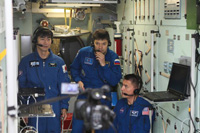This is JAXA’s Japanese astronaut activity report for October, 2014.
Astronaut Kimiya Yui trains in Russia as a backup member of the 41S flight crew
Astronaut Kimiya Yui, assigned as a crew member for the ISS Expedition 44/45 mission, underwent training for the upcoming ISS long-duration mission at the Gagarin Cosmonaut Training Center (GCTC) in Russia.
The expedition 44/45 crew, including Yui, was assigned as backup to the Expedition 42/43 crew who will fly to the ISS aboard the Soyuz TMA-15M spacecraft (41S). As the launch of the 41S, which had been scheduled for November 24 (Japan time), was approaching, Yui trained for the Soyuz spacecraft and the ISS Russian segment as one of the backup crew for the 41S flight.

Yui and his crewmates train in the mockup of the Russian segment (Credit: JAXA/GCTC)
Yui and his crewmates rehearsed the manual operations of the Soyuz spacecraft, including rendezvous, approach, and docking to the ISS, and atmospheric re-entry operations after undocking from the ISS. A simulation of atmospheric re-entry was also held under a hypergravity condition generated by a huge centrifuge accelerator, which recreated the gravity he would experience during reentry. Finally, they took an exam to confirm their manual operational technique during each phase of the flight. Training in the ISS Russian segment included a daily operational simulation using a mockup.
On October 30 and 31, flight readiness examinations were held for the 41S prime and backup crews to test whether they were sufficiently skilled to fly aboard Soyuz and stay in the Russian segment for an extended period.
On October 30, the first day of the examination, the prime and backup crews took exams for the ISS Russian segment and Soyuz spacecraft respectively.

Yui and his crewmates taking a Soyuz exam (Credit: JAXA/GCTC)
Attired in the Sokol spacesuits, Yui and the backup crew members boarded the Soyuz simulator to take the exam.
Aboard the Soyuz spacecraft simulator, the crew responded to failures affecting Communication and Tracking Systems and distance measuring instruments, irregularity of the main engine, and fire.
On the second day, October 31, the prime and backup crews switched places. The prime crew took an exam for the Soyuz spacecraft, and the backup crew took one for the ISS Russian segment. Yui and his peers responded to various failures and emergencies, including the failure of Elektron (oxygen generator) and a fire which broke out in the Russian “Zvezda” service module.
Both prime and backup crews passed the examinations and remained ready for the flight.
Astronaut Takuya Onishi undergoes training for a long-duration ISS mission at the JSC
Astronaut Takuya Onishi, who was assigned as a crew member for the Expedition 48/49 mission to the International Space Station (ISS), underwent training for the ISS operations at the NASA Johnson Space Center (JSC).
During the Extravehicular Activity (EVA) training, Onishi donned a submersible Extravehicular Mobility Unit (EMU) and dived into a large pool containing a submerged full-scale ISS mockup in the Neutral Buoyancy Laboratory (NBL) to practice the procedure of replacing the exposed equipment on the ISS.
Other EVA training included Simplified Aid For EVA Rescue (SAFER) operation using a Virtual-Reality (VR) system; simulating a case in which he gets off the ISS during EVA.
Training for emergencies such as fire, sudden depressurization, and toxic spills covered lectures on equipment such as Portable Breathing Apparatus (PBAs), an air analyzer (Compound Specific Analyzer-Combustion Products: CSA-CP), an air leak detector (Ultrasonic Leak Detector: ULD), and Portable Fire Extinguishers (PFEs). Onishi practiced using each of these sets of equipment and the relevant response procedure.
Other training included Electrical Power Systems (EPS), Thermal Control Systems (TCS), and Communication and Tracking Systems (C&TS) that sustain ISS operations as well as learning an exercise procedure using Advanced Resistive Exercise Device (ARED). Onishi continued flight training using a T-38 jet trainer as part of his space flight preparation.
Astronaut Satoshi Furukawa undergoes robotic arm training at the JSC
From October 6-17, Astronaut Satoshi Furukawa underwent training for the robotic arm operations at the NASA JSC.
This training also constituted the assessment of an updated training curriculum and a means of refreshing and improving his operation skills. Feedback on the new training curriculum in the form of comments from Furukawa and other astronauts will be provided for future astronaut training.
Astronaut Koichi Wakata returns to Japan for a while and gives reports
On October 24, Astronaut Wakata returned to Japan for a while and took part in events to publicize his Expedition 38/39 mission in Hokkaido as well as Toyama and Okinawa prefectures. During his stay, he gave feedback about the Japanese Experiment Module “Kibo” to engineers of space-related manufacturers and also shared opinions on future manned space activities.


